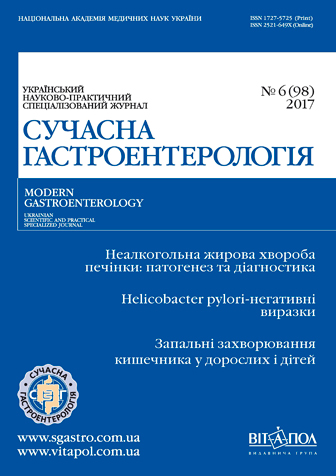- Issues
- About the Journal
- News
- Cooperation
- Contact Info
Current Issue. Articles
¹6(98) // 2017

1. Original researches
|
Notice: Undefined index: pict in /home/vitapol/sgastro.vitapol.com.ua/en/svizhij_nomer.php on line 74 Quality of life in pediatric patients with ulcerative colitisN. V. Chernega, M. F. Denisova, N. M. Muzyca, N. Yu. BukulovaSI «Institute of Pediatrics, Obstetrics and Gynecology of the National Academy of Medical Sciences of Ukraine», Kyiv |
|---|
Materials and methods. Examinations involved 64 children (36 girls and 28 boys) aged from 5 to 18 years with acute ulcerative colitis (UC). The UC diagnosis was verified by clinical examination, laboratory tests, endoscopyandmorphology. The QoLwas assessed with questioning with the use of a special international Inflammatory Bowel Disease Questionnaire (IBDQ), adopted for children with UC.
Results. The study of the QoL of children with UC allowed establishing the most negative effects on the state of health of the intestine and emotional factors, their dependence on the patients’ age and gender, degree of activity and localization of the process, thus giving the ground for the development of individual treatment schemes for this pathology in pediatric patients.
Conclusions. The QoL assessment in the UC pediatric patients proved to be a sensitive marker of the health-associated well-being of a sick child. In-depth investigation of the quality of life of children with ulcerative colitis, with account the disease clinical course, form, and activity, will allow determining the tactics of treatment for each individual patient.
Keywords: children, ulcerativecolitis, IBDQ, qualityoflife.
![]() To download
To download
full version need login
Original language: Ukrainian
2. Original researches
|
Notice: Undefined index: pict in /home/vitapol/sgastro.vitapol.com.ua/en/svizhij_nomer.php on line 74 Investigation of the role of certain intestinal hormones and pepsinogens in the pathogenesis of gastroesophageal reflux diseaseV. B. BoichukIvano-Frankivsk National Medical University |
|---|
Materials and methods. Examinations involved 80 patients with GERD. The GERD diagnosis was based on the diseaseanamnesis, patients’ complaints, results of 24-hours pH monitoring in the lower third of the esophagus, results of esophagogastroduodenoscopy, chromoendoscopy, 13C-octanoic breath test, serum levels of G-17, pepsinogens I and II (PI and II) and cholecystokinin-pancreozymin (C-P).
Results. The results of 24-hours pHmonitoring of the lower esophagusshowed the predominance of acid refluxes in 40 GERD patients and of the mixed refluxesin the rest of patients.In patients with predominance of acid refluxes, the mean values of the 13C-octanoic breath test (half-life excretion of solid food from the stomach) was (45.25 ± 1.34) min.In patients with the mixed refluxes, the hypergastrinemia was established, as well as the high C-P and PI II levels ((37.44 ± 3.41) μg/l; ð < 0.05), as well as a trend towards the hypokinetic stomach motility, evident due to the decreasedhalf-life excretion of solid food from the stomach up to (139.24 ± 11.87) min. In case of the predominance of acid refluxes, the significance reduction of the G-17, C-P and PI II levels was reveled, and increased PI I levels.
Conclusions. The results of 24-hours pH monitoring of the lower esophagus showed virtually equal rate of the acid and mixed refluxes.In case of the predominant acid refluxes, the accelerated stomachmotilitywas established, and the delayed motility was reveled in the patients with mixed refluxes.The acid refluxes prevailed in GERD patients with the low serum G-17 level and mixed reflux was more frequent in subjects with the increased levels. With the predominance of acid refluxes, blood levels of pepsinogen I was 3.5 times higher than in healthy people, and in case of the mixed reflux,it was within normal ranges with the increased levels of pepsinogen II.
Keywords: gastroesophageal reflux disease, daily pH monitoring in the lower third of the esophagus, 13C-octanoic breath test, gastropanel, cholecystokinin- pancreozymin.
![]() To download
To download
full version need login
Original language: Ukrainian
3. Original researches
|
Notice: Undefined index: pict in /home/vitapol/sgastro.vitapol.com.ua/en/svizhij_nomer.php on line 74 Three-channel esophageal and gastric 24-hours pH monitoring: equipment, technique, and clinical applicationO. O. KsenchynNational Pirogov Memorial Medical University, Vinnytsya |
|---|
Materials and methods. The study involved 28 patients (11 men and 17 women, the mean age 47 ± 2.4 years), from them GERD was diagnosed in 15 subjects, and functional gastric dyspepsia without GERD in 13 patients. The data, obtained with 3-channel esophageal and gastric 24-hours pH monitoring, were analyzed separately in the groups with GERD and without GERD.
Results. Medium and minimum values of intragastric pH as in the cardia and the body were lower in patients with GERD (p < 0.05 for cardia). Undoubtedly, esophageal monitoring of the is decisive in the GERD diagnosing, however the presence of daily intragastric pH high potency was considered as a predictor of GERD development.
Conclusions. The presence of more acidic stomach contents in patients suffering from GERD not only confirmed the major role of hydrochloric acid in a damaging effect on the esophageal mucosa and occurrence of symptoms, and should also be considered as a possible predictor of GERD in patients without severe clinical symptoms during the examination.
Keywords: gastroesophageal reflux disease, 3-channel esophageal and gastric 24-hours pH monitoring, functional gastric dyspepsia, acid-dependent diseases of the stomach.
![]() To download
To download
full version need login
Original language: Ukrainian
4. Original researches
|
Notice: Undefined index: pict in /home/vitapol/sgastro.vitapol.com.ua/en/svizhij_nomer.php on line 74 CT scanin patients with inflammatory bowel diseases: is it advisable to use it in the routine practice?O. S. PrymakMedical Center LLC «Health Clinic», Vinnytsya |
|---|
Materials and methods. A retrospective analysis was performed on 72 outpatient cardsof patients with suspected IBD or with established diagnosesof ulcerative colitis (UC) or Crohn’s disease (CD). All patientswere undergone a CT scan with the Aquilion-64 helix computer tomography scanner with 64-slices and with double-contrast method (oral and intravenous) for the primary diagnosis of IBD or to evaluate the effectiveness of the treatment. The patientswere divided into three groups: subjectswith suspected IBD, patients with established UC and CD diagnoses; and persons to be under regular medical check-up due to IBD, for whom CT was used to assess the efficacy of treatment.
Results. In patients of the 1st group, CT scan confirmed the UC and CD diagnosis (similar to the endoscopyresults) and allowed to reveal the terminal ileitis and the UCinitial stage of without visual changes in the mucosa during endoscopy but with signs of inflammation in the histology. Besides, it allowed disproving the IBD diagnosis and confirmingother diseases (diverticulitis, pseudomembranous colitis). In group 2 patients, CT scan gave the possibility to confirm or disprove the pre-exposed UC and CD diagnoses, and to detect concomitant pathology at an early stage (primary sclerosis cholangitis and hepatocellular carcinoma). For the subjects of group 3 CT scan enabled tracking of the treatment efficacyin patients with UC and CD, correct choice of the treatment tactics,and complications’ identifying.
Conclusions. The use of CT scan is advisable in the routine practice of diagnosis in patients with the suspected IBD, the established UC and CD diagnosis, as well as assessment of the treatmentefficacy.
Keywords: inflammatory bowel disease, ulcerative colitis, Crohn’s disease, CT scan.
![]() To download
To download
full version need login
Original language: Ukrainian
5. MEDICINES
|
Notice: Undefined index: pict in /home/vitapol/sgastro.vitapol.com.ua/en/svizhij_nomer.php on line 74 Management of patients with functional diarrheaO. V. ShvetzSI «State Scientific and Research Center with the Problems of Food Hygiene MoH of Ukraine», Kyiv |
|---|
Keywords: functional diarrhea, chronic diarrhea, stoolprevalence, diagnostic criteria, diet intervention, μ-opioid agonist, cholestyramine, probiotics, synbiotics.
![]() To download
To download
full version need login
Original language: Russian
6. MEDICINES
|
Notice: Undefined index: pict in /home/vitapol/sgastro.vitapol.com.ua/en/svizhij_nomer.php on line 74 Irritable bowel syndrome: the topicality of the problem and the issues of modern therapy according to Rome IV CriteriaI. G. Paliy, S. V. ZaikaNational Pirogov Memorial Medical University, Vinnytsya |
|---|
Keywords: Rome consensus IV, functional disorders of the gastrointestinal tract, irritable bowel syndrome, diarrhea, constipation, laxatives, antidiarrheal drugs, Mikrolaks®, Imodium®.
![]() To download
To download
full version need login
Original language: Ukrainian
7. Reviews
|
Notice: Undefined index: pict in /home/vitapol/sgastro.vitapol.com.ua/en/svizhij_nomer.php on line 74 Autoimmune hepatitis: a search for new solutionsV. P. Shypulin 1, G. D. Fadieienko 2, L. L. Pavlovskyi 1, V. V. Chernyavskyi 1, A. V. Neverovskyi 11 O. O. Bogomolets National Medical University, Kyiv |
|---|
Keywords: autoimmune hepatitis, prednisolone, azathioprine, budesonide, mycophenolatemofetil, tacrolimus.
![]() To download
To download
full version need login
Original language: Russian
8. Reviews
|
Notice: Undefined index: pict in /home/vitapol/sgastro.vitapol.com.ua/en/svizhij_nomer.php on line 74 Non-alcoholic fatty liver disease and metabolic disorders: what is primary?T. A. SolomentsevaSI «L. T. Mala National Therapy Institute of NAMS of Ukraine», Kharkiv |
|---|
Keywords: non-alcoholic fatty liver disease, non-alcoholic steatohepatitis, metabolic syndrome, obesity, diabetes, tumor necrosis factor, interleukin.
![]() To download
To download
full version need login
Original language: Russian
9. Reviews
|
Notice: Undefined index: pict in /home/vitapol/sgastro.vitapol.com.ua/en/svizhij_nomer.php on line 74 Hereditary pancreatitis: a brief review and the first case of diagnosis in UkraineN. B. Gubergrits 1, 2, N. V. Byelyayeva 1, 2, A. Ye. Rlochkov 1, P. G. Fomenko 11 Donetsk National Medical University, Lyman |
|---|
Keywords: pancreas, hereditary pancreatitis, mutation of the cationic trypsinogen gene, risk of pancreatic cancer, clinical observation.
![]() To download
To download
full version need login
Original language: Russian
10. Reviews
|
Notice: Undefined index: pict in /home/vitapol/sgastro.vitapol.com.ua/en/svizhij_nomer.php on line 74 Chronic inflammatory bowel disease and viral infectionsE. I. SergienkoKharkiv Medical Academy of Postgraduate Education |
|---|
Keywords: inflammatory bowel disease, ulcerative colitis, Crohns disease, viral infections, treatment, preventive care.
![]() To download
To download
full version need login
Original language: Russian
11. Reviews
|
Notice: Undefined index: pict in /home/vitapol/sgastro.vitapol.com.ua/en/svizhij_nomer.php on line 74 Diagnosis of nonalcoholic fatty liver disease: real opportunities and prospectsG. D. Fad³e³enko, I. E. Kushnir, Y. V. NikiforovaSI «L. T. Mala National Therapy Institute of NAMS of Ukraine», Kharkiv |
|---|
Keywords: diagnostics, NAFLD, NASH, fibrosis, fibrogenesis, non-invasive markers.
![]() To download
To download
full version need login
Original language: Russian
12. Reviews
|
Notice: Undefined index: pict in /home/vitapol/sgastro.vitapol.com.ua/en/svizhij_nomer.php on line 74 The multifactorial pathogenesis of non-alcoholic fatty liver diseaseV. M. ChernovaSI «L. T. Mala National Therapy Institute of NAMS of Ukraine», Kharkiv |
|---|
Keywords: non-alcoholic fatty liver disease, insulin resistance, metabolic syndrome, free fat acids, micro-RNA, endothelial dysfunction.
![]() To download
To download
full version need login
Original language: Russian
13. Reviews
|
Notice: Undefined index: pict in /home/vitapol/sgastro.vitapol.com.ua/en/svizhij_nomer.php on line 74 The phenomenon of Helicobacter pylori-negative ulcer and its place in clinical practiceV. ². Vdovychenko 1, Ya. B. Shvydkyi 1, A. V. Ostroglyad 21 Danylo Halytskiy Lviv National Medical University |
|---|
Keywords: Helicobacter pylori-negative peptic ulcer of the stomach and duodenum, epidemiology, etiology, pathogenesis, clinic, treatment.
![]() To download
To download
full version need login
Original language: Ukrainian
Current Issue Highlights
¹6(98) // 2017

Chronic inflammatory bowel disease and viral infections
E. I. Sergienko
The phenomenon of Helicobacter pylori-negative ulcer and its place in clinical practice
V. ². Vdovychenko 1, Ya. B. Shvydkyi 1, A. V. Ostroglyad 2
Log In
Notice: Undefined variable: err in /home/vitapol/sgastro.vitapol.com.ua/blocks/news.php on line 51

